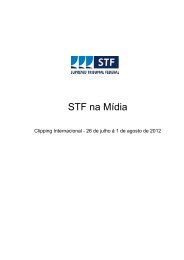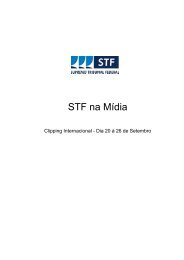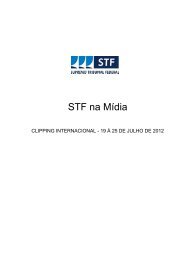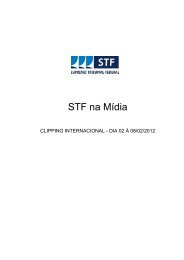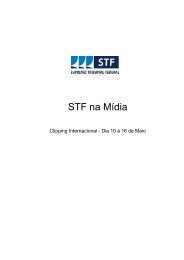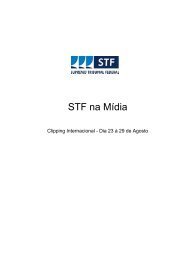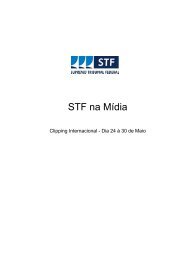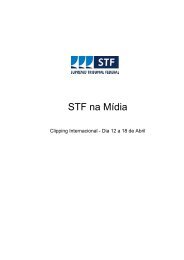STF na MÃdia - MyClipp
STF na MÃdia - MyClipp
STF na MÃdia - MyClipp
You also want an ePaper? Increase the reach of your titles
YUMPU automatically turns print PDFs into web optimized ePapers that Google loves.
The New York Times/ - Politics, Seg, 02 de Abril de 2012<br />
CLIPPING INTERNACIONAL (Supreme Court)<br />
Justices’ Cerebral Combativeness on<br />
Display<br />
WASHINGTON — The Supreme Court is usually the<br />
most remote and mysterious branch of American<br />
government. Not last week.<br />
Over three days of intense arguments on the future of<br />
President Obama’s health care law, the public got a<br />
vivid glimpse of an institution at once immensely<br />
powerful and intensely human, one packed with brainy,<br />
funny and assertive justices prepared to confront and<br />
decide the most urgent issues of the day.<br />
“It seemed that they were at an intellectual feast,” said<br />
David J. Garrow, who teaches history and law at the<br />
University of Pittsburgh. Indeed, the justices exhibited<br />
an appetite for debate that seemed to wear out the tag<br />
team of lawyers who appeared before them.<br />
A decision in the case is expected by late June. In the<br />
meantime, the court will hear arguments in a challenge<br />
to Arizo<strong>na</strong>’s tough immigration law, and it will soon<br />
confront cases concerning affirmative action in higher<br />
education and a request to reconsider the Citizens<br />
United campaign fi<strong>na</strong>nce decision. Cases on voting<br />
rights and same-sex marriage are not far behind.<br />
It can seem that the court is prepared to decide every<br />
major controversy in American life. “They are quite<br />
willing to flex the muscles of judicial review,” Thomas<br />
C. Goldstein, a Washington lawyer and the publisher<br />
of the Web site Scotusblog, said of the justices.<br />
Last week’s arguments illumi<strong>na</strong>ted two different<br />
aspects of the court led by Chief Justice John G.<br />
Roberts Jr.: an intellectual side at ease with legal<br />
issues of colossal complexity, and a pithy,<br />
conversatio<strong>na</strong>l side that can frame issues in accessible<br />
nuggets.<br />
The two facets emerged on different days. The<br />
arguments on peripheral issues, on Monday and<br />
Wednesday, were often highly technical.<br />
“I am a law professor and have been quite interested<br />
in this case,” said Benjamin H. Barton, who teaches at<br />
the University of Tennessee. “I had a pretty hard time<br />
following those arguments.”<br />
The crucial session on Tuesday, on the<br />
constitutio<strong>na</strong>lity of the law’s requirement that most<br />
Americans obtain health insurance or pay a pe<strong>na</strong>lty,<br />
was different.<br />
“The justices went right to the heart of the matter in a<br />
way that most Americans can understand,” Professor<br />
Barton said.<br />
Justice Ruth Bader Ginsburg, for instance, crisply<br />
made the administration’s case for why the health care<br />
market warrants special treatment. The point, she said,<br />
was not “my choice whether I want to buy a product to<br />
keep me healthy.” Rather, it is “the cost that I am<br />
forcing on other people if I don’t buy the product.”<br />
Justice Antonin Scalia made a contrary point with<br />
equal vigor. The powers not granted to the federal<br />
government by the Constitution belong to the states<br />
and the people, he said. “And the argument here,” he<br />
went on, “is that the people were left to decide whether<br />
they want to buy insurance or not.”<br />
The court released audio recordings each day,<br />
allowing the public prompt access to the substance<br />
and tenor of the arguments, unmediated by scholars<br />
and commentators.<br />
There was an important lesson in the arguments, said<br />
Lee Epstein, who teaches law and political science at<br />
the University of Southern California.<br />
“The teachable moment here isn’t for the public,” she<br />
said. “It’s for the law professors and elite lawyers who<br />
were all predicting a slam-dunk for the Obama<br />
administration.”<br />
The verbal and a<strong>na</strong>lytic skills the justices brought to<br />
the argument were a reflection of what sort of person<br />
gets nomi<strong>na</strong>ted to the Supreme Court these days. As<br />
a new study from Professor Barton demonstrates, the<br />
current court is distinctively different from earlier ones.<br />
Before they joined the Supreme Court, for instance,<br />
its current members spent less time in private practice<br />
and more time in Washington than any previous set of<br />
nine justices.<br />
The current justices also spent more years at college<br />
and law school in the Ivy League or at Stanford than<br />
had any previous court. Indeed, every current justice<br />
attended law school at Harvard or Yale (with Justice<br />
Ginsburg transferring from Harvard to Columbia).<br />
188



